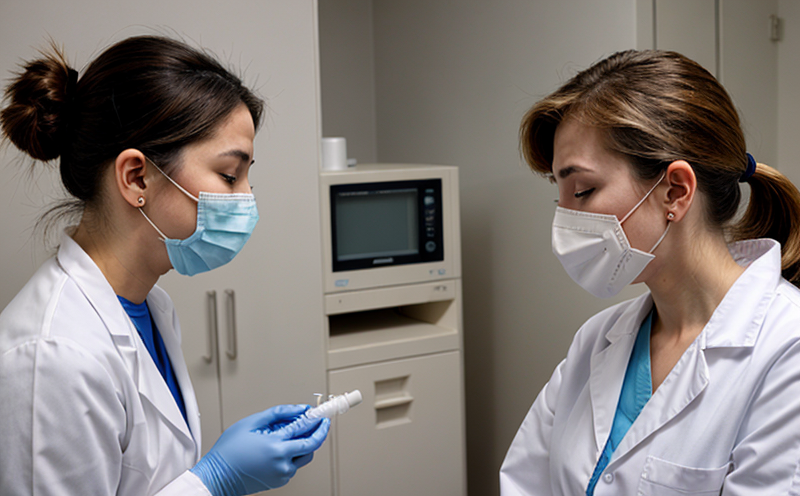Latex Allergen Protein Testing in Medical Devices
The testing of latex allergen proteins is crucial in medical device manufacturing to ensure patient safety and compliance with international standards. Latex, a natural rubber derived from the Hevea brasiliensis tree, is widely used in various medical devices such as gloves, syringes, catheters, and stethoscopes due to its flexibility, durability, and biocompatibility.
However, latex contains proteins that can provoke allergic reactions. These reactions range from mild symptoms like itching and hives to severe anaphylactic shock, which could be fatal if left untreated. Therefore, the identification of allergen proteins in medical devices is paramount for healthcare safety and regulatory compliance.
The testing process involves several critical steps. First, samples are prepared by extracting allergen proteins from the latex used in the device. This step requires precise handling to avoid contamination and ensure accurate results. Next, the extracted proteins are analyzed using immunoassay techniques such as ELISA (Enzyme-Linked Immunosorbent Assay) or RIA (Radioimmunoassay), which can detect specific allergen proteins.
The testing process is governed by several international standards that ensure consistency and accuracy. For instance, ASTM D6950, ISO 13485, and EN 450 are widely recognized in the medical device industry for their stringent requirements on quality management systems, design controls, and risk management processes.
Accurate testing not only ensures patient safety but also protects manufacturers from legal liabilities. Compliance with these standards can enhance brand reputation and foster trust within healthcare providers. In addition, by minimizing latex-related allergic reactions, the use of latex in medical devices becomes more accessible to a broader population.
| Standard | Description |
|---|---|
| ASTM D6950 | Test method for determining the amount of residual protein in latex rubber products used in medical devices. |
| ISO 13485 | International standard for quality management systems specifically for the design and manufacture of medical devices. |
| EN 450 | A European standard that provides requirements for quality assurance in the production of medical devices. |
The testing process is not only a regulatory requirement but also an ethical responsibility. By ensuring that latex allergen protein levels are within acceptable limits, manufacturers can contribute to a safer healthcare environment. This practice aligns with the principles of evidence-based medicine and patient-centered care.
Benefits
- Enhanced patient safety by minimizing allergic reactions.
- Compliance with international standards, ensuring quality and reliability.
- Potential for legal protection against product liability claims.
- Better brand reputation through ethical manufacturing practices.
- Increased accessibility of medical devices to patients with latex allergies.
The benefits extend beyond the immediate impact on patient health. By implementing robust allergen protein testing, manufacturers can also reduce operational risks. Regular testing helps identify and mitigate potential issues early in the production process, reducing the likelihood of product recalls and associated costs.
Moreover, compliance with these standards can lead to increased market access in regions where stringent regulations are enforced. This is particularly important for medical device manufacturers aiming to expand their global footprint.
Industry Applications
- Detection of residual latex proteins in surgical gloves and examination gloves.
- Assessment of allergen levels in catheters, intravenous (IV) lines, and other vascular devices.
- Evaluation of the biocompatibility of latex-based medical adhesives and dressings.
The testing of latex allergen proteins is particularly important for medical devices that come into direct contact with patients. These include surgical instruments, diagnostic tools, and any device that may be used in patient care settings. By ensuring low levels of allergens, manufacturers can significantly reduce the risk of adverse reactions, thereby enhancing patient safety.
The table below highlights some applications where latex allergen testing is crucial:
| Device Type | Potential Allergic Reaction |
|---|---|
| Surgical Gloves | Hives, itching, and in severe cases, anaphylactic shock. |
| Catheters | Localized inflammation and increased risk of infection. |
| Vascular Devices | Potential for blockages and reduced blood flow. |
The identification of allergen proteins in these devices is essential to ensure that they meet the highest standards of quality and safety. This testing process plays a vital role in protecting patients from potential health risks associated with latex exposure.
Use Cases and Application Examples
- Surgical Glove Manufacturing: Testing for residual allergen proteins before the final production step ensures that gloves meet strict safety standards. This testing helps manufacturers identify any potential contamination issues early, allowing for corrective actions.
- Catheter Design: During the design phase of catheters and other vascular devices, testing is conducted to ensure that the device does not contain excessive allergen proteins. This step is critical to prevent adverse reactions during patient use.
These examples illustrate how latex allergen protein testing is integrated into various stages of medical device development and manufacturing. By incorporating this testing process early in the design and production phases, manufacturers can significantly reduce the risk of allergic reactions and ensure compliance with international standards.
- Dressing Adhesives: Testing for allergens in medical dressings ensures that they are suitable for use by patients with latex allergies. This is particularly important for wound care products where skin contact is prolonged.
- Vascular Implants: Assuring the biocompatibility of vascular implants involves testing for allergen proteins to prevent chronic inflammation and other immune responses.
The consistent application of these tests across various stages of medical device development enhances overall product safety and patient care. By adhering to stringent testing protocols, manufacturers can ensure that their products meet or exceed regulatory requirements, thereby protecting both patients and healthcare providers.





